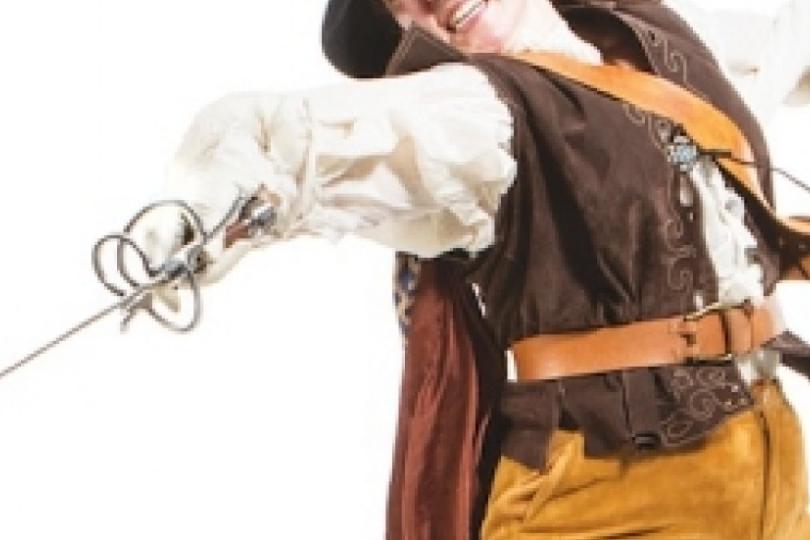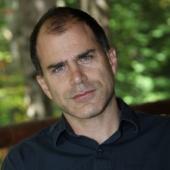REVIEW: 'The Three Musketeers' and 'Dirt Sticks'
Review

A dashing young adventurer leaves his rustic village for the big city with nothing but a note from his father and an old yellow horse – a mysterious peddler is pulled along by the currents of the moon, dispensing his magical wares and cryptic advice – a corrupt Cardinal hides his political scheming behind fawning smiles and his church’s red robes – a man on the cusp of adulthood questions his identity as past and present collide in a swirl of memory and ghosts – both Walking Shadow and Ten Thousand Things are playing like happy children in the thick loam of old-fashioned storytelling.
And that’s just scratching the surface – dare we ignore the lascivious landlord, or the mysterious talking pigeon? The templates are flying as Walking Shadow attempts to re-stage a classic for modern audiences and Ten Thousand Things does the same – with classic fairy-tale elements in a new work. Neither is old-fashioned in a pejorative sense – the strange feeling I had during act one of The Three Musketeers was clarified by an audience member talking to his daughter at intermission: It’s like a Jason Bourne movie, only two hundred years ago. I’ve been a fan of Three Musketeers since the two-film ‘70s blockbuster directed by Richard Lester I saw as a boy. I went on to read all the books, see the original Gene Kelly, and proudly disdain all the subsequent remakes.
But I never noticed what an obvious ancestor it is to almost every action movie you’ve ever seen (complete with subordinate female characters, though Dumas makes his women much more integral to the story). Pop film theory says Jaws and Star Wars reoriented movie-making toward the action-blockbuster – that may be true when it comes to raw numbers – but Lester’s Three Musketeers predates both, and its story elements – the young rookie, the team of cool, well-humored experts, the secretly evil Cardinal (or Police Chief, or CEO), the King (or Captain) who would gladly have our heroes’ back if only they’d stop screwing around – are a template that’s been adjusted to different genders, countries and centuries – yet the audience never seems to tire of it.
My Aunt Rose, God rest her, often came to my plays when I still lived in NYC. She was up for almost anything, as long as there was “a good story” – both my Grandmother and my Mom referred to the soap operas they watched daily as “my stories.” There may be a surprising number of theatre artists ready to argue the point, but in general the audience remains addicted to the well-told tale with characters they can affectionately cheer or enjoyably hiss. That traditional story-structure is a dastardly plot of the capitalist patriarchy, I have no doubt – though even a card-carrying member like myself often chafes against the rules.
Critically, of course, you can’t win. A play diverting too drastically from traditional story-telling is chided just as often as a play that doesn’t divert at all. Since most critics lack the space (or inclination?) to go over theatre history or technical analysis, it’s difficult to know whether it’s anything more than a matter of taste. But when playwrights talk shop, they’re as happy to sink below the artistic fairy-dust to the technical bones of a play as, say, a bunch of carpenters sitting around a pitcher of beer talking about how furniture is made.
And when their fellow artists turn to the well-told tale, they invite the comparison to carpentry: have they built a story you can sit in comfortably, or does it collapse under your weight. As I mentioned, I’m a big fan of Musketeers, so when I sat in the darkness of the Guthrie Lab wondering what the hell the evil Cardinal’s scheme was, why he hated the Queen so much, and which freakin’ war they were all talking about, I went back to those movies I loved as a boy, where no less a worthy than Charlton Heston played the part (Heston was known for biblical epics – having him play the bad guy was a big deal). In Walking Shadow’s defense, the movies are no less clear on the Cardinal’s motives, though we do get a better sense of where we are historically, which battles are being fought and why. A glance at Wikipedia reveals the Cardinal to be a truly fascinating historical creature (apparently he invented the position of Prime Minister – which actually clears up quite a bit).
I’ll confess it’s somewhat unfair to compare Walking Shadow’s production to a pair of movies – but only somewhat. I could re-read the books and post this essay some time in July, or I could try to understand my confusion by looking at how another set of artists adapted the same material for a dramatic medium. It’s also fair to say that, like a blockbuster audience, some people will shrug off their confusion with the intricacies of the plot as long as they know the difference between the white hats and the black. Now that we have automatic mass feedback via the Internet, I’ve noticed a disturbing trend toward treating confusing plot points as some kind of bold artistic gesture. From Lost to True Detective there’s a bizarre refusal to call out bad carpentry, as if an initial loyalty to a story demands you defend it to the death. In one way, this reinforces the notion of how attached the audience gets to plot and character – but as a would-be technician myself, it’s somewhat alarming to hear audience members passionately defend the carpenter who left them sprawled on the floor with splinters in their ass.
Our country has love/hate relationship with culture, consuming enormous amounts of it, while at the same time denigrating its value (you wouldn’t know from political attitudes toward the arts that – for example – it beats out tourism as a money-maker). This dismissiveness often moves from economic worth to social worth – but one glance at these feedback threads – whether for film, television or theater – and you realize just what kind of power storytellers have over their audience. Is it too far a leap, then, to say the choices storytellers make sometimes acquire an ethical dimension?
One such choice is exactly which stories merit repetition. Shakespeare hung quite a bit on plots like Musketeers, but Dumas was just trying to have a good time. Walking Shadow attempts to cram in even more material than both movies, and with roughly the same running time it’s a bit of a traffic jam. I’m not sure a kid can sit still for all this, and for adults the cluttered traffic coupled with the absence of Shakespearean psychology begins to itch. As for the swashbuckling – I know this is insider baseball, but you can almost hear the fight choreographer telling the actors not to hurt each other – which is exactly what they’re playing. A certain razzle-dazzle can make up for that, and those staircases begged for a little Robin Hood action – but we never go there. And so, in a way, we never taste whatever it is about this story that so excites Walking Shadow, or why they felt passionate about presenting it to us.
My editors have requested I try and stick to one play per essay, but I was intrigued by the storytelling angle of both shows I saw last week, the second being Dirt Sticks a new play by Kira Obolensky, presented at Open Book by Ten Thousand Things. I doubt anyone reading this needs to be reminded of Ten Thousand Things’ signature style – suffice to say they strip away most of the technical trappings of contemporary theatre, leaving only the actors and the audience, in full view of each other. Intentionally or not – their mission seems more political than metaphysical – this methodology demonstrates the roots of theatre in religion and ritual – the company makes no overt effort to create a sacred space, yet the sacred space creates itself anyway.
The first Ten Thousand Things show I ever saw was The Good Person of Szechwan (Brecht was an infamous enemy of narrative who, like Aunt Rose, couldn’t resist a good story). I was enraptured by their method back then, and remain enraptured almost a decade later – but once again I found myself sitting in a chair that couldn’t hold my weight (maybe I’m just getting old – or, more appropriate to the metaphor, fat). The red- hot core of Kira’s fairy-tale – the past that creates the present we’re watching – is riveting and beautifully tragic, and all of the writing is of course gorgeous – but until that moment of clarity I felt myself drifting in and out of focus depending on which of the marvelous cast members was the center of the action (the cast is uniformly excellent, in delightfully different ways). The dream-like coherence of fairy tales (almost as if they’re actual dreams, but of entire cultures rather than individuals) is a difficult note to hit. I felt the rock-solid bones of Kira’s tale – how the tragic past haunts these characters, and what lengths they must go to dispel it – dissolving into digression. At the risk of completely overloading the metaphor, Kira’s play is definitely a chair – it may even be an Eames – but there’s so many cushions and blankets on it I kept sliding off.
Joseph Campbell created a survey of mythology to complement his Hero With A Thousand Faces. Called The Masks of God, it begins at the dawn of time, and ends, with the fourth book, Creative Mythology in the 20th Century. Creative Mythology posits our new myths will be created by artists we can actually know, unlike Homer or the Gospel writers – who represent a more collective tradition. Anyone tracing the evolution of Sherlock Holmes will see how solid his theory remains (just as anyone who scoffed at my ethical point might note how the second Spider-Man trilogy or The Hobbit cynically exploit the audience’s hunger for these new myths). Kira Obolensky, and to a lesser extent, Waking Shadow, are stepping up to Campbell’s roster of mythmakers – a vital and potentially dangerous role. The audience loves stories, and can grow remarkably attached to characters and situations – Kira, like Sherlock Holmes, has chosen to use her eccentric, obsessive powers for the good of the community. She’s just beginning a three-year residency with Ten Thousand Things (sponsored by the Mellon Foundation) – I would be joining the dismissive to give up on her project at first blush. Instead, I’m excited to see what myths she and Ten Thousand Things will offer us next.




